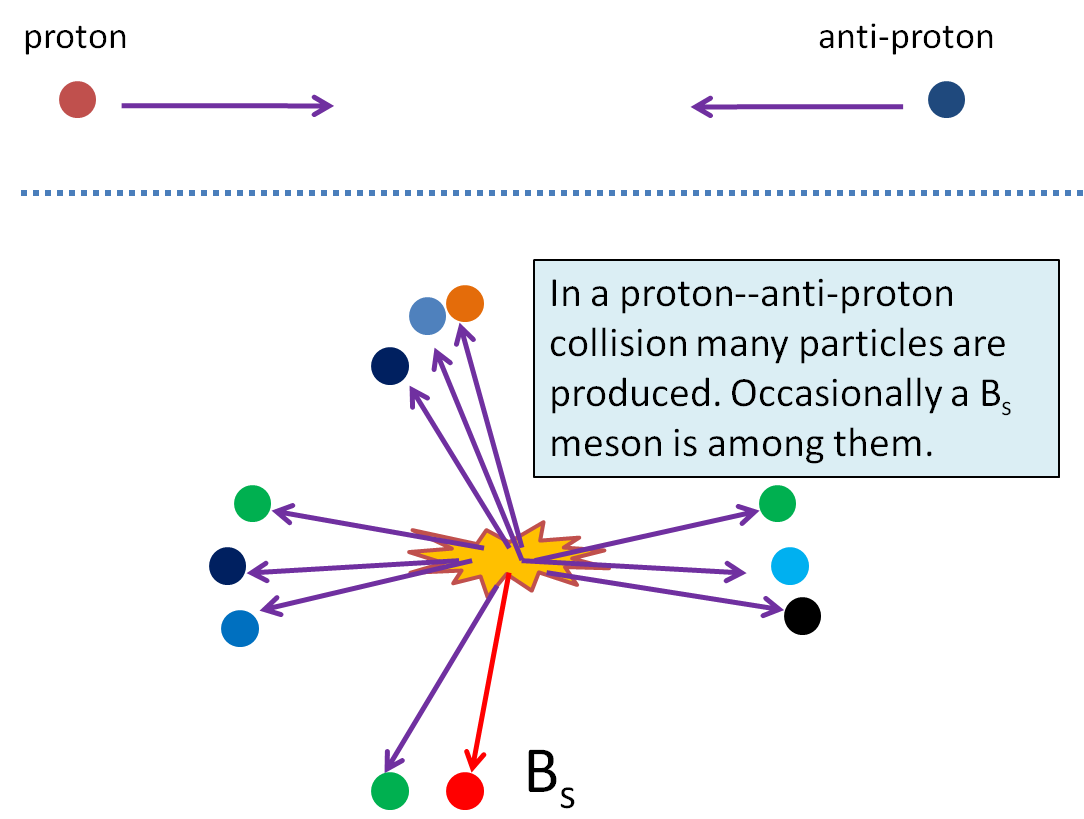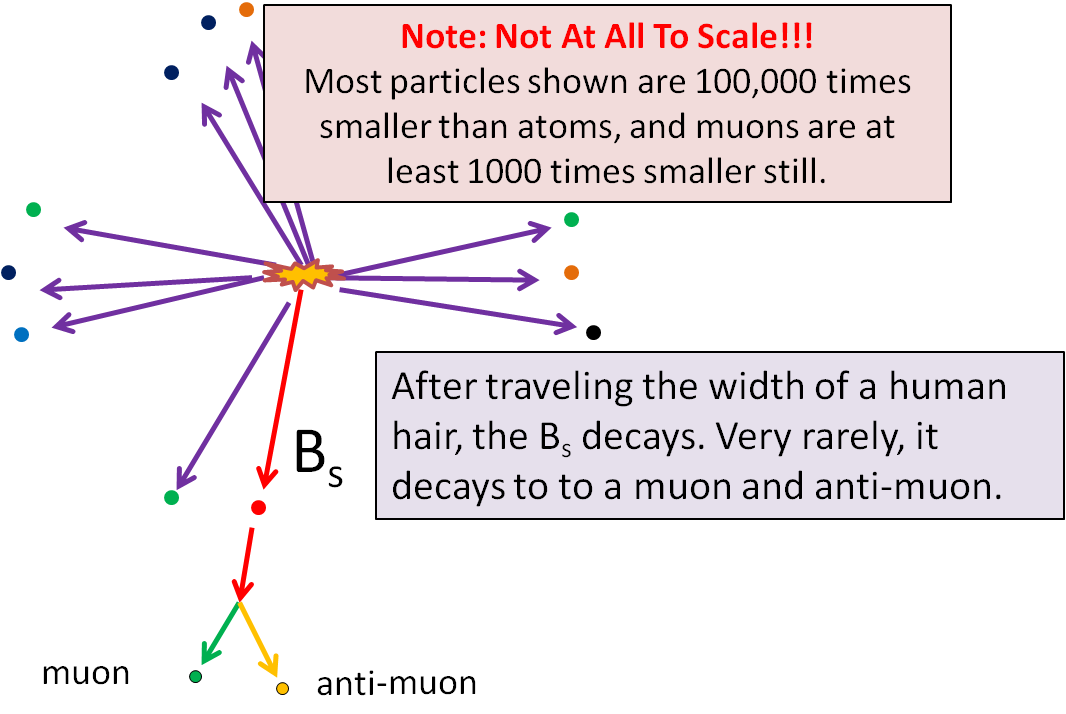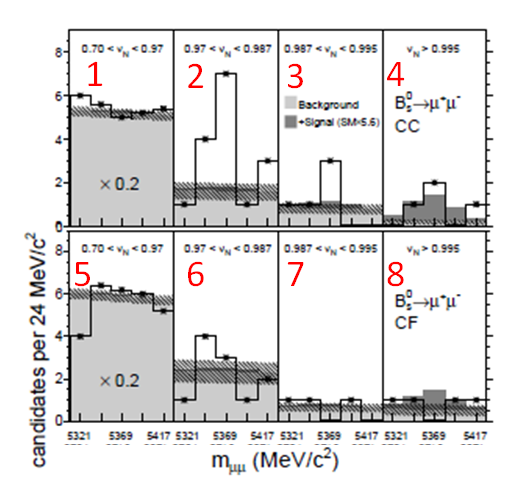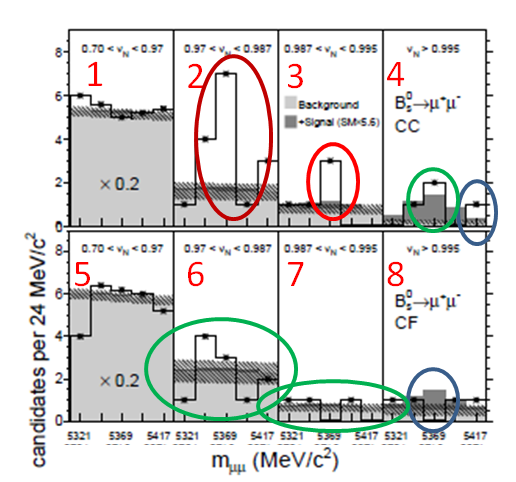There is word (7/14/11) that the CDF experiment at the Tevatron has observed a long-sought rare process, at a rate that is somewhat larger than predicted in the Standard Model of particle physics. [Update 1 is at the end of the article (7/16/11)] [Update 2 is at the start of the article (7/28/11)]
This could be a hint of new physics, though it could also just be an upward statistical fluctuation. So this is quite interesting, but too early to get very excited about. In any case the measurement will soon be cross-checked at the Large Hadron Collider and perhaps at the Tevatron’s DZero experiment. If all the experiments observe a higher rate than expected, then it will really be time to get excited.
UPDATE 2: They didn’t. At the EPS-HEP11 EuroPhysics conference last week, the LHCb experiment and the CMS experiment both reported results on the process that is described in this article. Neither observed it, and the LHCb result especially was powerful enough to disfavor the result from CDF. But not quite strong enough yet to rule it out. To say it another way: CDF saw something that was most likely to be as much as 5.6 times the Standard Model prediction, but could have been smaller; they did however assert that the rate was at least 1.5 times higher than expected. Meanwhile LHCb was able to exclude, at 90% confidence, anything larger than about 3.7 times the Standard Model prediction. So that means that if nature generates this process at 2.5 times the Standard Model, it would, I think, be consistent with all three experiments and still be a breakdown of the Standard Model. But at this time there is no strong evidence for any problem with the Standard Model prediction; the most likely issue is that CDF’s measurement is quite challenging. With more data coming over the next year, the LHC experiments should observe this process and measure it precisely.
Here’s how it’s done: events are chosen with a muon (a heavy cousin of the electron) and an anti-muon (the muon’s anti-particle.) Then the energies of the muon and anti-muon are combined in such a way as to answer the following question: if there were a parent particle that decayed (i.e. disintegrated) into the observed muon and anti-muon, and nothing else, what would the mass of the parent particle have to have been?

There are lots of random sources of muons and antimuons in the Tevatron’s proton-antiproton collisions, so most of the time an observed muon and anti-muon pair do not come from a single particle, and the answer to the above question is some random number. But now consider a particular particle: the B_s meson, which is a particle containing a bottom quark and a strange antiquark (or vice versa), [along with other junk, just like the proton.] Suppose this particle can decay to a muon and an anti-muon. Then more often than random we should see the answer to our above question being the mass of the B_s meson (which is very precisely known).
In other words, if we make a plot of the number that is the answer to the question above, we should see a roughly flat distribution if the answer is random, and a peak above the random noise if there are B_s mesons decaying to a muon and an anti-muon. This peak has been observed (you can try to figure this out from the CDF [pre-publication] paper) and it is several times bigger than expected, hinting that perhaps there is new physics beyond the standard model indirectly enhancing this process.

Unfortunately there are some initially confusing aspects of the paper and its plots, and I need to read it more carefully before giving you a proper analysis. Stay tuned… [Update is below]
What is particularly nice about this measurement is that it is very clean and relatively simple. Compared to some of the other discrepancies from the Standard Model that the Tevatron experiments have claimed to see, this one is much less likely to result from a subtle error on the part of either theorists or experimentalists. Having read the paper more carefully, I am no longer entirely convinced of this. See below.
But this kind of excess with a small number of events can happen just on its own. In my line of work, we’ve all seen more striking hints go away many times before. So at this point, the right thing to do is to keep watch. Don’t bet your house on this hint sticking around, but do listen in when the other experiments report on their own versions of this measurement. Meanwhile physicists like me will be thinking about what it might mean if this hint of something new turns out to be real.
I will update this post when I learn more, hopefully today or tomorrow.
UPDATE 1 7/16/11 (I expect there will be at least one more)
Well, this is not as simple a study as I thought it was… the experimentalists had to work a lot harder than I initially realized, because what they are looking for is such a rare process that there are a lot of other rather rare processes they have to remove first.
And there are enough confusing elements to this data that I am not yet sure I have everything straight yet. So please take this update as an indication of how I go about figuring these things out, not yet as the final word.
The killer plot for this analysis, taken from the CDF paper and slightly annotated by me for my current purposes, is this one:

Each data dot represents a certain number of collisions with an observed muon-antimuon pair — the number of events is at the left, running from 0 to 8. Each of the eight panels represents a different class of events. And each of the five bins in each panel represents a different parent-particle mass – with the central bin representing the mass of the B_s meson.
The light grey bands represent the best guesses about other unwanted rare processes that leak into the data. The dark grey bands represent how big the B_s meson process of interest would be, if it were 5.6 times larger than the standard model expectation. (Let’s ignore the hashing that’s on the graphs, to keep things simple — it just represents how uncertain the guess is on the light-grey band.) And again the dots (and redundant black lines that connect them) are the data.
The classes of events that are most pure and are the best to look at are those in panels 4 and 8. The fact that there are two events in the central bin of panel 4, and one event in an adjacent bin, is what this whole discussion is about. Because if the standard model were correct, at most one event should appear in the central three bins, and probably none. Since CDF observed three, right around the mass of the B_s meson — that is the “peak above random background” that is mentioned earlier in this article — it is possible that the rate for B_s to decay to a muon-antimuon pair is significantly larger than in the standard model.
More precisely: In this context, there are two hypotheses floating around
- A: The B_s meson decays as expected in the standard model (and the data should just about match the light-grey bands, up to statistical fluctuations).
- B: The standard model is not correct and the B_s meson decays to muon-antimuon pairs roughly 5 — 6 times more often than predicted (and the data should match the light+dark grey bands — note that in some panels the dark grey is almost too small to see.)
You can see that the data in the central bins of panel 4 match hypothesis B and not hypothesis A. I’ve circled that in green below.
But there are a number of worrying things about the data taken as a whole. No one of them is disturbing on its own, but taken together they bother me.
Notice that in most of the other panels — except panel 8 — you can barely see the dark grey bands. (Ignore the hashing; I’m talking about the solid dark grey.) That’s because in those panels it’s the other processes, not B_s decay, that are expected to be dominant. In panels 6 and 7, the data matches the light grey background well. In some bins it is a little higher, in some bins a little lower, but that’s what you’d expect [green circles]. The weird things are in panels 2 and 3 [red circles]. In panel 2, there are too many events — 18 observed where about 9 were predicted by both hypothesis A and hypothesis B — especially in the same bins that are high in panel 4. In the second and third bin of panel 2 there are a total of 11 events where just under 4 are expected. That’s quite a lot. Then in panel 3, the total number of predicted and observed events is the same — 5 — but again there is a slightly surprising 3 events over an expectation of 1 exactly in the central bin. Finally, it is a bit surprising that there is also an event [blue circle] in the last bin of panel 4, which is not expected in either hypothesis A or B. And maybe one last unfortunate thing: in panel 8 [blue circle], there are no events in the bin where the prediction was for 1 or 2 events, if hypothesis B were correct.
Let me emphasize one more time: no one of these things taken on its own seems that unusual. It is the pattern among them that disturbs me. In fact I would naively say:
- Panels 5 through 8 — which collect data on one general class of events — are compatible with either hypothesis, and very slightly prefer hypothesis A (no excess) because of panel 8.
- Panels 1 through 4 — which collect the data on a different general class of events — are not compatible with either hypothesis, because of panel 2, though they slightly favor hypothesis B because of panel 4.
A reasonable person might then wonder if we need a third hypothesis — perhaps this is a problem with the interpretation, or a problem with the data analysis itself. But to propose anything in particular one would really need to fully understand how the data is divided up into panels 1,2,3 and 4. I do not understand this at all yet.
Anyway, I am sure my CDF colleagues considered every point I raised here before they made their result public, and I am sure they have some answers to all my questions. They may simply tell me that my statistics is too naive and my concerns about panel 2 are overblown. In any case, I will be trying to learn more about their point of view over the coming week. If it leads to a change in my interpretation I will update this page.




One Response
Pr. Strassler,
This hands on analyis is very intresting and educative. Any new results that confirm or infirm hypothesis A or B?
You have made many of my days lately, I have read most of your articles. Big thank you for your effort in clarifying many concepts, laying a solid and serious ground.
Merci, Claude